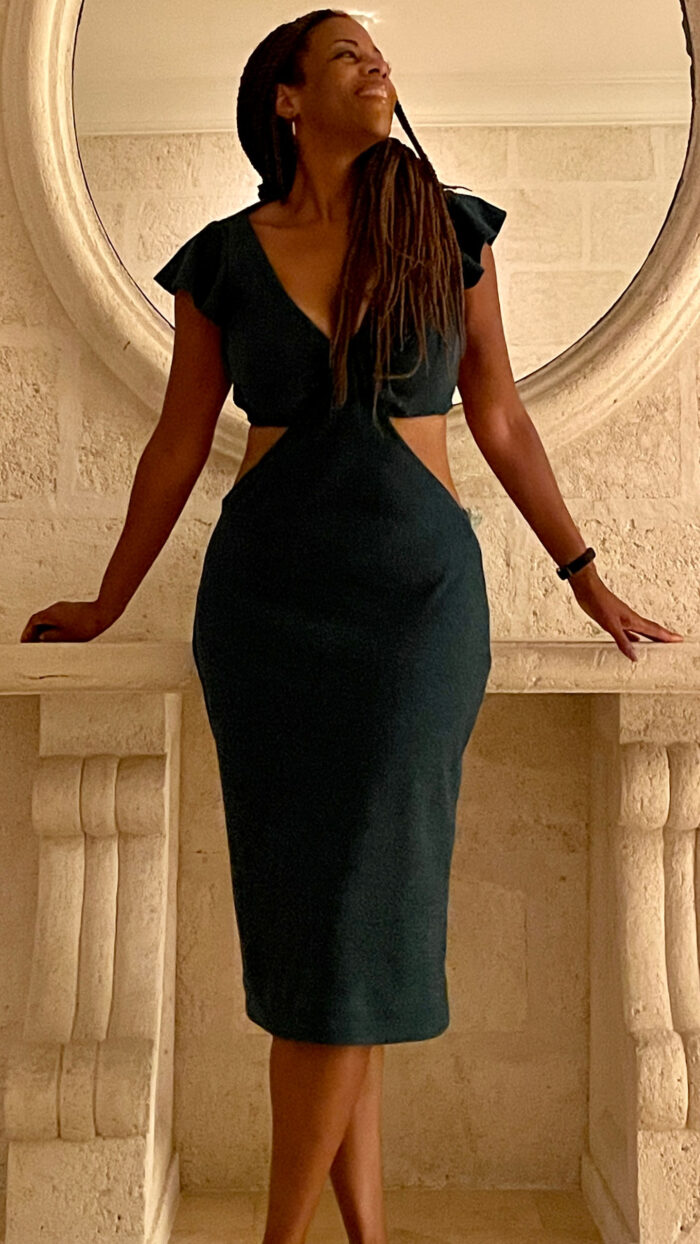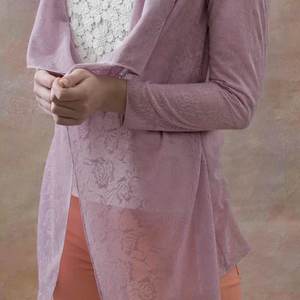
It’s time to choose your favorite runway-inspired look from among the five semifinalists of the Runway Sewn Your Way Challenge.
Voting is now closed. We’ll announce the audience-choice winner December 3, 2021. Our digital ambassadors will choose their favorite, too, and the winner will also be announced December 3, 2021 at ThreadsMagazine.com.
 |
 |
 |
 |
 |
The semifinalists are listed in no particular order below.
|
 |
 |
 |
 Claire McCardell-inspired halter dress
Claire McCardell-inspired halter dress
Inspiration: Billed as one of the “25 Most Iconic Fashion Ensembles in the History of the Museum at FIT (Fashion Institute of Technology)” by Newsweek in 2019, Claire McCardell’s 1951 cotton piqué formal menswear-style halter top and dirndl skirt inspired me to enter the Threads 2021 Digital Ambassadors’ Runway Sewn Your Way Challenge. The juxtaposition of a very feminine dress using formal menswear design elements was key. I integrated these two ideas into one design with contrasting effect.
How did you make it your own? I made this iconic design my own, calling it Classic & Timeless: Simply Beautiful and Quietly Chic, by changing several key elements. First, I changed the two-piece top and skirt into a one-piece dress with self-belt. Second, I played up a more formal menswear look by exchanging gathers at the neck and waistline for pleats. My intent was to copy the look of a men’s tuxedo shirt. Continuing with the theme of a very formal menswear look, I made a white collar (similar to a men’s formal shirt) and purchased a men’s dark blue silk bow tie. Lastly, I shortened my version for a more versatile day-to-evening look.
• Changing the two-piece top and skirt into a one-piece dress with self-belt: I used Folkwear 258 Town & Country Dress as a starting point, as it was a one-piece halter dress.
• Exchanging gathers at the neck and waistline for pleats: Claire McCardell’s 1951 design had gathers at the neckline and waistline, a nice repetition of a design element. The pattern I used called for pleats at the neckline and gathers at the waist. In order to mimic design elements, I had to either convert the pleats to gathers at the neckline or convert the gathers to pleats at the waistline. Since I loved the very formal menswear look and I am tall, I chose the harder of the two options, converting gathers to unpressed pleats at the waistline. In the book What Shall I Wear? by Claire McCardell (Simon and Schuster, 1956), she discusses the wearing of pleats. “If you are tall, you can manage the widening look of unpressed pleats, very beautiful as you walk because they swirl and move gracefully.”
• Contrasting collar and bow tie: Unlike Claire McCardell’s original design made entirely of one fabric (white cotton piqué), I incorporated three contrasting colors and fabrics: beige wool, white cotton sateen and dark blue silk for a striking look.
• Shorter hemline: I expect to get a lot of mileage out of a shortened, more versatile day-to-evening version, as I am able to wear it year-round in Arizona. All of my natural fiber fabrics “breathe.”
Pattern: I used Folkwear 258 Town & Country Dress pattern (out of print).
Fabrics: I used 2-1/2 yards of beige tropical weight, almost tissue-paper thin, wool (Sir Pendleton by Pendleton Woolen Mills) for the dress and self-belt and 1/4 yard of white cotton sateen for the contrasting collar. I also used 1/4 yard of silk organza for interfacing and 1 yard of Bemberg rayon for the bound edges and seams.
Trims and embellishments: I auditioned two dark contrasting colors for the trims and embellishments (black and dark blue). Although it is easier to find vintage dressmaking supplies (e.g., buttons, belt buckles, etc.) and fashion accessories (e.g., shoes, gloves, etc.) in black, I felt the dark blue was not as harsh a color and unexpected. I used couture techniques throughout (e.g., sew-in silk organza interfacing, Hong Kong finishes, stays along the neckline and bodice sides, hand-applied collar and invisible side zipper, hand-knotted thread eyes, etc.). I adorned the front with a row of dark blue buttons with rhinestone centers, my version of tuxedo studs. I made a two-inch self-belt with a dark blue belt buckle. I auditioned many dark blue belt buckles, eventually settling on one that mimicked the long vertical lines throughout my design. For the vintage look, I bought a dark blue cardigan with three-quarter-length sleeves, rounded toe pumps and a structured handbag. For the evening look, I bought a dark blue satin border silk chiffon scarf (worn as a shawl), pointed-toe suede pumps and a metallic box clutch.
Challenges and enjoyment: My greatest challenges in creating the look were fitting the bodice and converting 90 inches of fabric into pleats at the waistline.
• The bodice was frustrating. I made many muslins and stood through many fittings to perfect the fit of the bodice. My bust and waist measurements required pattern alterations. Just when I thought I had the bodice perfect, I attached the skirt and discovered the weight of the skirt pulled the bodice down thus making the halter bodice (which resembles a men’s backless waistcoat) too low on the sides and back. The solution was to raise the sides and back of the bodice. In the end, those painfully frustrating do-overs are but a distant memory!
• Converting 90 inches of fabric into pleats at the waistline required painstakingly correct measurements and precise folds to form the pleats. Believe it or not, my favorite part of the process was hand-pleating and hand-basting all those waistline pleats!
 |
 |
 |
 Max Mara-inspired reversible wrap coat
Max Mara-inspired reversible wrap coat
Inspiration: A hooded wrap coat by Max Mara inspired this garment. I like the cozy look and the versatility of wearing it open or closed. The coat is simple, modern, and easy to wear.
Trims and embellishments: The only “embellishment” on this garment is topstitching on all the seams and edges. The topstitching serves a practical purpose of keeping all the seams in place and making sure that the edges don’t roll.
Challenges and enjoyment: The most challenging part of this project, and the part that I most enjoyed, was cutting out the plaid to get the best possible match. The front of the coat has a princess seam that can only be matched on its lower half. This had to be perfect so that the patch pocket that straddled this seam would match and be almost invisible. Matching the side seams and the center-back seam required some compromises. The shoulder seams were impossible to match due to the way the hood was cut, but they are covered by the hood most of the time. Matching the sleeves also required some compromises. Overall, I am happy with how the matches turned out. The other tricky aspect of this coat is getting the lengths of the sleeves and hems for each side of the coat to match. I hung the coat for 24 hours before sewing the final hem and sleeve hem seams to allow the fabrics to relax and then cut everything to the same length before sewing. This method is the most reliable when combining fabrics with different weights.
 |
 |
 |
 Jenny Packham-inspired yellow gown
Jenny Packham-inspired yellow gown
Inspiration: My inspiration came from the Jenny Packham Spring 22 Collection, especially look No. 1/Mars dress. I discovered this collection when I became enamored with the gold sequin dress worn by Kate Middleton that was in Packham’s 007 capsule collection. When I scrolled through her beautiful gowns, I fell in love. Her gowns have all the details that I love—drapey fabrics, sparkle, feminine silhouettes. The collection transported me to pre-COVID times of people getting glammed up for special occasions and the holidays. It just gave me a happy feeling, so I wanted to create the same feeling in what I was about to make for this challenge.
How did you make it your own? I used the Mars dress as jump-off point for my inspiration. I made a few tweaks to suit my style and taste, because I had decided to make something I can actually wear and make good use of. First, I changed the plunging neckline to a high neck to make it practical for me. Next, I chose a fabric that was more light, flowy, and comfortable. Instead of sequins, I opted for a stretch jersey. Then, I chose a color that evokes happiness in me, especially as the weather is starting to get gloomy (a bright yellow), which also complements my skin tone. I loved the silhouette, so I did a similar one, but I placed my pleats/ruching differently to suit my body type.
Pattern: I did not use any patterns for this garment. I chose to drape it completely on my dress form. I used a book as a guide, Draping by Annette Duburg/Rixt van der Tol (Artez Press, 2014). The style was inspired by a 1938 dress by Madame Grès, that is featured in the book. I made my own tweaks to it in the neckline and sleeves.
Fabrics: I used a stretchy jersey. I bought 5 yards but used about 4 yards of it.
Trims and embellishments: I used gold embroidery appliqué at the shoulders, armholes, back, and the waist.
Challenges and enjoyment: My first challenge was choosing only one inspiration, because I have so many favorites and they all took me in a different direction. It took me a long time to settle on one. After a while, I started to see a pattern in the styles I kept going back to, and was eventually able to settle on a collection. I was going back and forth between two silhouettes, but ultimately, I decided to make something I would wear later, which helped me focus my plan. I really appreciated the whole challenge because it pushed me to make something I would otherwise not have. I learned a lot.
 |
 |
 |

Cult Gaia-inspired cut-out dress
Inspiration: I am a huge fan of the cut-out trend. It allows you to be sexy while still covered at the same time. I had seen the Cult Gaia Serita dress just about everywhere on everyone and liked it but needed more coverage. So I was inspired to create my own version.
How did you make it your own? I made a few modifications to create a bit of “modesty”. I widened the straps on the bodice and added flutter sleeves. I also shortened it to knee length rather than mid-calf to better suit my 5-foot, 6-inch frame.
Patterns: For the bodice and the skirt of the dress, I used Simplicity 8982. I borrowed the flutter sleeve from Butterick 6208.
Fabric: The Kristin sweater knit from Zelouf Fabrics had the perfect amount of stretch and recovery for this project. It is a supersoft fabric and clung to my curves but was still breathable. I used about 2 yards of fabric.
Trims and embellishments: No
Challenges and enjoyment: Making the pattern alterations was a fun but challenging process. This was unusual for me, but I particularly enjoyed the fitting process for this project.
 |
|
 |
OFFICIAL RULES | Privacy Policy | Terms of Use
































Log in or create an account to post a comment.
Sign up Log in